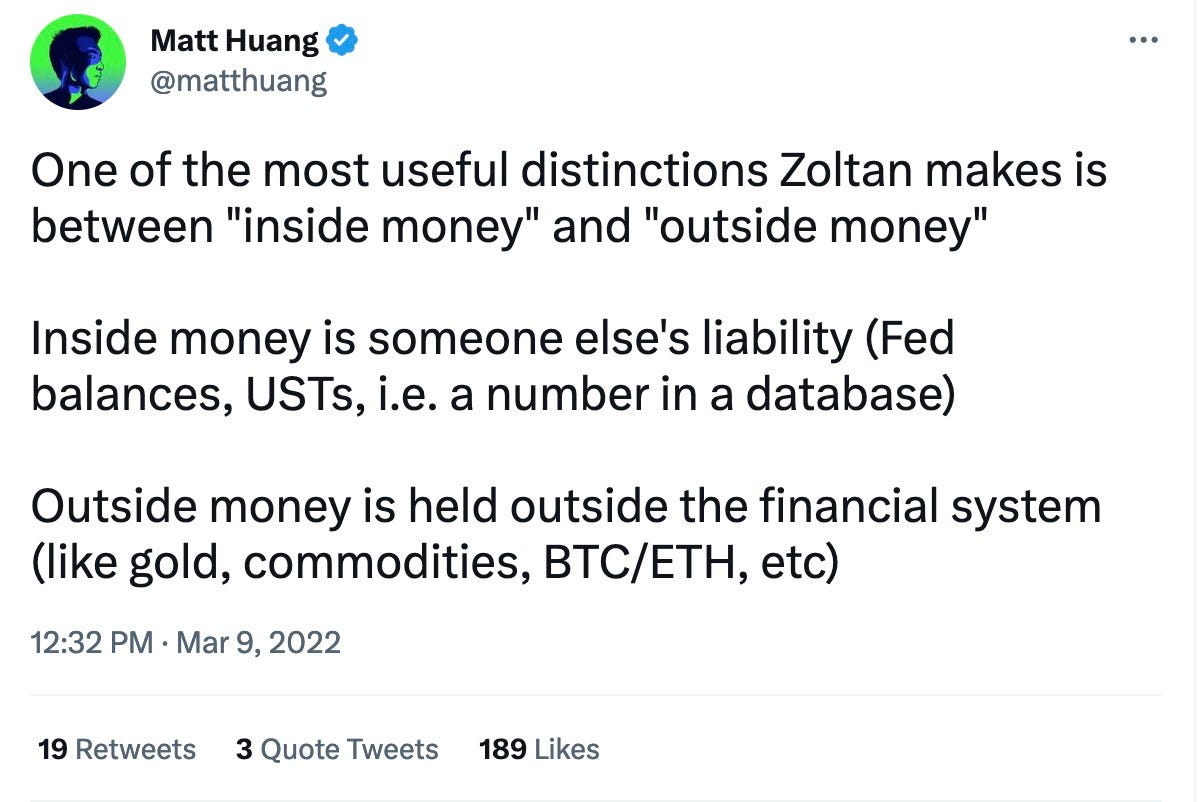No, Bitcoin is not "outside money"
A short note discussing what 'inside and outside' money actually mean.
In a research note titled Bretton Woods III, Zoltan Pozsar, a well regarded rates strategist at Credit Suisse, argues that our monetary system will transition "From the Bretton Woods era backed by gold bullion, to Bretton Woods II backed by inside money (Treasuries with un-hedgeable confiscation risks), to Bretton Woods III backed by outside money (gold bullion and other commodities).” He then ends the article by concluding:
After this war is over, ‘money’ will never be the same again......and Bitcoin (if it still exists then) will probably benefit from all this.
As expected, this is well received in the crypto space as a strong pro-bitcoin argument:
Here’s Arthur Hayes in "Energy Cancelled”:
And here’s Messari’s Crypto theses for 2023:
Such a definition of inside vs. outside money is misguided — at least, they constitute a mischaracterization or adaptation of the terms’ academic origins.
The concept of Inside and Outside Money were initially coined in 1960, by John G. Gurley and Edward S. Shaw in their work Money in a Theory of Finance. A more digestible version of the concept can be found in Lagos (2006). The original definitions of inside and outside money are as follow:
Inside money is an asset representing, or backed by, any form of private credit that circulates as a medium of exchange. Since it is one private agent’s liability and at the same time some other agent’s asset, inside money is in zero net supply within the private sector. The qualifier inside is short for (backed by debt from) inside the private sector.
Outside money is money that is either of a fiat nature (unbacked) or backed by some asset that is not in zero net supply within the private sector of the economy. Thus, outside money is a net asset for the private sector. The qualifier outside is short for (coming from) outside the private sector.
All this might sound like some economic jargon, but essentially the difference is this: In Zoltan’s definitions, Inside money are monetary instruments that exists as liabilities on another player’s balance sheet, regardless of who that player is, even if it’s a liability of the sovereign. Outside money are simply commodities such as gold or Bitcoin.
The actual definitions suggest that inside money is an asset representing a form of private debt (non-governmental). Outside money is money that is not created by private credit and exists as a liability of the government that could or could not be backed by some other asset. Another simplified way to understand this is that, if the liability resides inside the private sector (e.g. bank deposits) then the money is inside money. If the liability resides outside the private sector (e.g. cash, central bank reserve) then the money is outside money.
Commodity like gold and bitcoin in this case could be used by central bank to regulate outside money, but not necessarily, since they can also just be of fiat nature backed by the ‘full faith and credit’ of a sovereign state.
To understand the relationship between ‘inside money’ and ‘private credit’, we need to talk about how money is created in the modern economy. The best explanation of this concept is articulated in this article by the Bank of England1.
The key concept is that, rather than banks receiving deposits when households save and then lending them out, bank lending creates deposits. Money creation in practice differs from the popular misconception — banks do not act simply as intermediaries, lending out deposits that savers place with them, and nor do they ‘multiply up’ central bank money to create new loans and deposits. Banks do receive deposits, but they can also create deposits as a result of their loans. Banks are kept in check by competition, and those that do not make profits or risk losses from excessive lending would go out of business.
Consider a scenario where a household takes out a mortgage loan to purchase a house. In this case, the loan would be considered a liability for the household. However, the same amount would appear as an asset in the form of a bank deposit on the balance sheet of the entity that sold the property. The assets and liabilities generated by the creation of inside money are perfectly balanced, resulting in a net zero position on the overall private-sector balance sheet. When a loan is paid back, the corresponding deposit is extinguished, and inside money is destroyed.
Inside money is important because it facilitates economic activity by providing credit to people and businesses, enabling them to finance purchases of goods and services and undertake investments. Faith in inside money (i.e. your bank deposits) is based on the ability of these banks to trade them for the money of another bank or central bank money.
Back to Zoltan’s article, his argument actually has a lot to do with the theories regarding the credit vs. commodity theory of money. In his view, the monetary base could not continue to expand based on the ‘full faith and credit’ of the sovereign and the monetary system need to return to a commodity-backed era. In any case, this is a separate issue which has nothing to do with inside or outside money.
Further Reading:
I sometimes wonder why this is not required reading for every intro econ course





